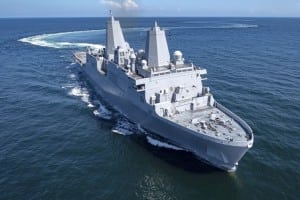The Navy’s FY 2021 budget request said the service is seeking $30 million to start working on a future amphibious ship and another $30 million on a future logistics ship.
In the budget highlights book, the Navy said it plans to invest the requested $60 million for research and development of the new intra-theater vessels able to support both Expeditionary Advanced Base Operations (EABO) and Littoral Operations in a Contested Environment (LOCE).

“A next generation medium amphibious ship will be a stern landing vessel to support amphibious ship-to-shore operations” while the medium logistics ship “will be a platform support vessel to support theater lift requirements,” the document continued.
The Navy’s budget justification documents explained the Navy will evaluate the amphibious vessel in accordance with the Marine Corps Commandant’s Planning Guidance and Chief of Naval Operations’ Warfighting Requirements and Capabilities direction in support of the upcoming Integrated Naval Force Structure Assessment (INFSA).
The documents said the FY ’21 funds will “support concept evaluation/design, industry studies and exploration for a medium lift intra-theater amphibious support vessel. Efforts include requirements development, systems engineering, naval architecture and marine engineering, and operations research analysis.”
The $30 million is divided into $21.5 million for industry studies and design, $6 million for project management and engineering support, $2.5 million for special studies, and $1 million for a U.S. government indicative design.
Last week, Commandant of the Marine Corps Gen. David Berger explained his perspective on amphibious forces, including the need for more smaller ships.
“I think our amphibious fleet has great capability. It is not enough for 2030. It is not enough for 2025. We need the big decks, absolutely. We need the LPD-17, that is the mothership, the quarterback and the middle. But we need a light amphibious force ship, a lot of them that we don’t have today,” Berger said at an Amphibious Warship Industrial Base Coalition event.
Affirming the concept of Distributed Maritime Operations (DMO), Berger asked then what is the amphibious force that is going to work for that.
“We need to support the fleet, Marines need to be an integral part of and directly support the fleet. We need to be able to do that from a dispersed posture, we need to rearm ships, rearm planes, refuel everything. We need to be able to sense, target, kill from forward in the dispersed manner from ship or from shore.”
The FY ’21 budget document also explained the new logistics vessel effort comes in the wake of the Navy establishing an Intra-Theater Auxiliary Logistics Platform Task Force to evaluate the next generation medium platform solutions for logistics mission requirements that also support LOCE and DMO.
“This includes a family of vessels with commercial designs tailored for military applications,” the documents said.
The $30 million in FY ’21 will specifically “support concept evaluation, ship configuration development, and industry studies focused primarily on the Refuel, Resupply, and Rearm logistics missions. Efforts include requirements development, systems engineering, naval architecture and marine engineering, and operations research analysis.”
The Navy said this non-acquisition program will be one “that designs, develops, and tests the Integrated Naval Force Structure Assessment, to evaluate next generation medium platform solutions for logistics mission requirements in support of Distributed Maritime Operations and Littoral Operations in Contested Environment.”
The FY ’21 dollars will be divided into $21.6 million for industry studies and designs, $6 million for project management and engineering support, $2.5 million for special studies, and $1 million for U.S. government indicative design.